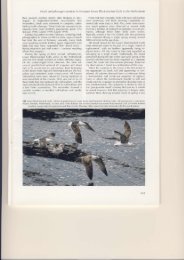Identification of American Herring Gull in a western European context
Identification of American Herring Gull in a western European context
Identification of American Herring Gull in a western European context
You also want an ePaper? Increase the reach of your titles
YUMPU automatically turns print PDFs into web optimized ePapers that Google loves.
<strong>Identification</strong> <strong>of</strong> <strong>American</strong> <strong>Herr<strong>in</strong>g</strong> <strong>Gull</strong> <strong>in</strong> a <strong>western</strong> <strong>European</strong> <strong>context</strong><strong>Gull</strong> L californicus, Iceland <strong>Gull</strong> L glaucoides,Thayer’s <strong>Gull</strong> L thayeri and Glaucous <strong>Gull</strong> thanto Largentatus, their results thus support<strong>in</strong>g theCSNA hypothesis. Crochet et al (2002) held backfrom unreservedly recommend<strong>in</strong>g that smithsonianusbe regarded as a full species, preferr<strong>in</strong>g towait until their results were confirmed us<strong>in</strong>glarger sample sizes <strong>of</strong> all North <strong>American</strong> taxa.Additional unpublished data gathered by several<strong>in</strong>dependent research teams (Pierre-AndréCrochet <strong>in</strong> litt) confirm the earlier f<strong>in</strong>d<strong>in</strong>gs andhave led to the formal recommendation by theAssociation <strong>of</strong> <strong>European</strong> Rarities CommitteesTaxonomic Advisory Committee (AERC TAC) that<strong>American</strong> <strong>Herr<strong>in</strong>g</strong> <strong>Gull</strong> be treated as a species,Larus smithsonianus.Comment<strong>in</strong>g on the taxonomic position <strong>of</strong><strong>European</strong> <strong>Herr<strong>in</strong>g</strong> <strong>Gull</strong> populations, the CSNA(Sangster et al 1998) stated that ‘there is no evidencethat the form ‘argenteus’ is diagnosablydist<strong>in</strong>ct from argentatus’ and concluded thatargenteus was conspecific with argentatus. Wequestion the supposed lack <strong>of</strong> evidence thatargenteus is not diagnosably dist<strong>in</strong>ct from argentatus.From our perspective, argentatus-types andargenteus-types are <strong>of</strong>ten readily separable <strong>in</strong> thefield (plate 23 and 35) and appear to fulfil sufficient‘requirements <strong>of</strong> diagnosability’ to merittaxonomic recognition.We prefer, therefore, to treat argenteus as adiagnosable taxon. While we realise that, <strong>in</strong>reality, the variation <strong>in</strong> <strong>European</strong> <strong>Herr<strong>in</strong>g</strong> <strong>Gull</strong>seems to be much more complex than the simple‘argentatus’ and ‘argenteus’ model, we do notknow if much <strong>of</strong> the yet-to-be expla<strong>in</strong>ed andquantified variation has a particular bear<strong>in</strong>g onthe identification <strong>of</strong> smithsonianus <strong>in</strong> Europe. Inthis paper, we follow the conventional arrangement,whereby L a argentatus refers to the<strong>Herr<strong>in</strong>g</strong> <strong>Gull</strong> which breeds <strong>in</strong> Fennoscandia,around the Baltic and White Seas and L aargenteusrefers to the on-average slightly smaller andlighter-mantled type which breeds <strong>in</strong> Iceland,Brita<strong>in</strong>, Ireland and from Brittany, France, toapproximately southern Denmark – although itapparently forms a mixed population withLaargentatus <strong>in</strong> the area rang<strong>in</strong>g from the north<strong>of</strong> the Netherlands to southern Denmark (Barth1975); the term ‘<strong>European</strong> <strong>Herr<strong>in</strong>g</strong> <strong>Gull</strong>’ is usedto refer to L aargentatus/argenteus.While it is beyond the scope <strong>of</strong> this paper todiscuss further possible (sub)specific variationwith<strong>in</strong> smithsonianus, it seems likely, given thecomplexity <strong>of</strong> ‘herr<strong>in</strong>g gull’ taxonomy <strong>in</strong> an area1 <strong>American</strong> <strong>Herr<strong>in</strong>g</strong> <strong>Gull</strong> / Amerikaanse Zilvermeeuw Larus smithsonianus, juvenile, Cape May, New Jersey, USA,September 1996 (Pat Lonergan). Individuals as dark as this one should not pose any identification problems <strong>in</strong> Europe.3










